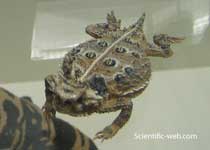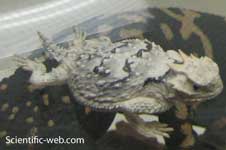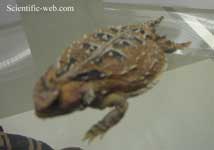Phrynosoma hernandezi, Phrynosoma platyrhinos calidiarum , Phrynosoma cornutum
Horned lizards (Phrynosoma) are a genus of the Phrynosomatidae family of lizards. The horned lizard is popularly called a "horned toad," "horny toad", or "horned frog," but it is neither a toad nor a frog. The popular names come from the lizard's rounded body and blunt snout, which make it resemble a toad or frog. (Phrynosoma literally means "toad-bodied.") The spines on its back and sides are made from modified scales, whereas the horns on the heads are true horns (i.e. they have a horny core). There are 14 species of horned lizards in North America, 8 of which are native to the United States. The largest-bodied and most widely distributed of the U.S. species is the Texas horned lizard (P. cornutum). Description Horned lizards are morphologically similar to the Australian thorny devil (Moloch horridus), but are only distantly related. They also have other unique similarities, such as being sit-and-wait predators and preying upon ants, and so the two species are considered a great example of convergent evolution. ction. If approached too closely, they generally run in short bursts and stop abruptly to confuse the predator's visual acuity. If this fails, they puff up their body to cause it to look more horny, making it appear larger and more difficult to swallow. At least four species are also able to squirt an aimed stream of blood from the corners of the eyes for a distance of up to 5 feet. They do this by restricting the blood flow leaving the head, thereby increasing blood pressure and rupturing tiny vessels around the eyelids. This not only confuses predators, but also the blood tastes foul to canine and feline predators. It appears to have no effect against predatory birds. To avoid being picked up by the head or neck, horned lizards duck or elevate their head and orient their cranial horns straight up, or back. If a predator tries to take it by the body, the lizard drives that side of its body down into the ground so that the predator cannot easily get its lower jaw underneath the lizard. Diet and decline The diet of most horned lizards species varies from 60-90% harvester ant of the genus Pogonomyrmex, though they are opportunistic and supplement these with termites, beetles, crickets, grasshoppers and other small live insects. In California, Texas, and other states, horned lizards are considered threatened and given state protection, though none are on the federal endangered species list. The Texas horned lizard has declined in about 30% of its range, though there is some indication it may be making a comeback. Some California species are also in decline. The decline is usually blamed on development/destruction of habitat, the spread of non-native South American ants which compete and war with the harvester ant, and the overuse of pesticides which kill harvester ants. In California, the introduced species is the Argentine ant.[1] In Texas, it is the Argentine ant and the Brazilian fire ant. Both species are highly aggressive and fiercely territorial, and prey on harvester ant queens, destroying the horned lizard's principal source of food. In culture Some Native American peoples regarded horned lizards as sacred. The animal is a common motif in the art of many Native Americans in the Southwestern U.S. (namely, Navajo) and in Mexico. In the Clint Eastwood film The Outlaw Josey Wales, the character played by Chief Dan George decides to go to Mexico based on signs given to him by a horned toad. The horned lizard is the state reptile of both Texas and Wyoming, and as the "horned frog," is the mascot of Texas Christian University (TCU). The horned toad is also the mascot of Coalinga High School in Coalinga, California. The town also holds an annual "Horned Toad Derby". Species and subspecies
Notes 1. ^ "Proliferation Of Argentine Ants In California Linked To Decline In Coastal Horned Lizards", Science Daily (March 5, 2002). External links
Retrieved from "http://en.wikipedia.org/" |
|



